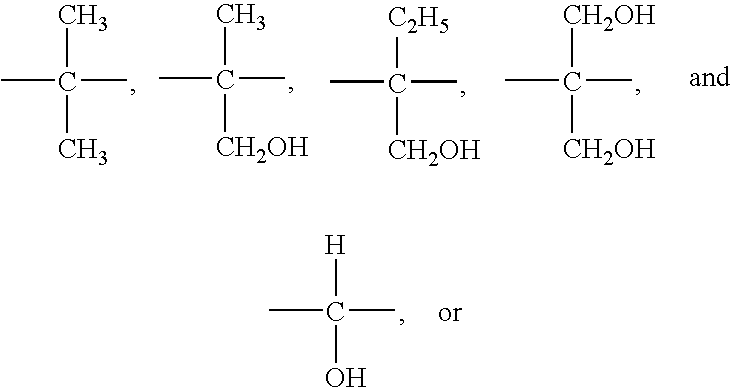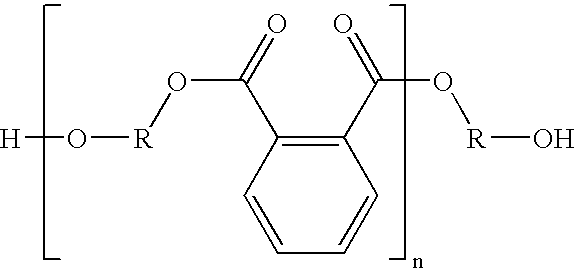Phthalate polyester polyl-based and high dimensionally stable all water-blown spray polyurethane foam derived therefrom
a technology of phthalate polyester and spray foam, which is applied in the direction of thin material handling, transportation and packaging, etc., can solve the problems of no water blown spray foam being practical or effective, no vacuum-induced shrinkage, and not producing uniform coverage over the substrate of foam, etc., to reduce polymer reliance, reduce vacuum-induced shrinkage, and reduce the effect of pressure equalization
- Summary
- Abstract
- Description
- Claims
- Application Information
AI Technical Summary
Benefits of technology
Problems solved by technology
Method used
Image
Examples
example 2
[0207]
3 EXAMPLE 2 Phthalate Polyester (Stepanpol PS-3152) 37.02% Terate Polyester (Terate-203) 14.81% Propoxylated Glycerine (Voranol-270) 22.21% Surfactant (L-5440) 2.04% Cell Opener (Calcium Stearate) 0.30% Amine Catalysts* 5.18% Lead Catalyst (30% Pb Naphthanate) 0.22% 2-Ethylhexanoic Acid 0.37% Diluents** 14.81% Water 3.04% *Amine catalysts: Polycat 8 = 2.22%; Dimethylethanolamine = 2.22%; Curithane 52 = 0.74%. **Diluents: tris-isopropylchlorophosphate.
[0208]
4 Hand Mix Properties Mix Ratio (A / B by Volume) 1:1 Component Temperatures 77.degree. F. Initiation Time 5 sec. Tack Free Time 12 sec. Cup Density 2.53 pcf Resin Viscosity (77.degree. F.) 550 cps
[0209] Machine Sprayed Properties (Gusmer H-2; GX-7 Gun; 120.degree. F. Temps.; 800 psi Pressures)
5 Density (with passline, ASTM D-1622) 2.76 pcf Density (no passline, ASTM D-1622) 2.19 pcf Compressive Strength (with passline, ASTM D-1621) 26.9 psi Compressive Strength (no passline, ASTM D-1621) 22.8 psi Shear Strength (with passline...
example 3
[0210]
6 Phthalate Polyester (Stepanpol PS-3152) 46.11% Propoxylated Sucrose (Pluracol P-975) 23.05% Surfactant (L-5440) 2.11% Cell Opener (Calcium Stearate) 0.21% Amine Catalysts* 5.77% Lead Catalyst (30% Pb Naphthanate) 0.15% 2-Ethylhexanoic Acid 0.38% Diluents** 19.21% Water 3.01% *Amine catalysts: Polycat 8 = 2.50%; Dimethylethanolamine = 2.50%; Curithane 52 = 0.77%. **Diluents: tris-isopropylchlorophosphate = 11.53%; Makon 10 = 7.68%.
[0211]
7 Hand Mix Properties Mix Ratio (A / B by Volume) 1:1 Component Temperatures 77.degree. F. Initiation Time 5 sec. Tack Free Time 12 sec. Cup Density 2.56 pcf Resin Viscosity (77.degree. F.) 680 cps
[0212] Machine Sprayed Properties (Gusmer H-2; GX-7 Gun; 120.degree. F. Temps.; 800 psi Pressures)
8 Density (with passline, ASTM D-1622) 2.64 pcf Density (no passline, ASTM D-1622) 2.25 pcf Compressive Strength (with passline, ASTM D-1621) 30.3 psi Compressive Strength (no passline, ASTM D-1621) 17.2 psi Shear Strength (with passline, ASTM C-273) 22.3 ...
example 4
[0213]
9 Phthalate Polyester (Stepanpol PS-3152) 45.27% Mannich Polyol (Voranol 470X) 20.89% Diethylene Glycol 3.48% Surfactant (L-5440) 2.09% Cell Opener (Calcium Stearate) 0.35% Amine Catalysts* 3.55% Diluents** 21.58% Water 2.79% *Amine catalysts: Polycat 8 = 1.25%; Dimethylethanolamine = 1.95%; Curithane 52 = 0.35%. **Diluents: tris-isopropylchlorophosphate = 14.62%; Makon 10 = 6.96%.
[0214]
10 Hand Mix Properties Mix Ratio (A / B by Volume) 1:1 Component Temperatures 77.degree. F. Initiation Time 6 sec. Tack Free Time 13 sec. Cup Density 2.81 pcf Resin Viscosity (77.degree. F.) 600 cps
[0215] Machine Sprayed Properties (Gusmer H-2; GX-7 Gun; 120.degree. F. Temps.; 800 psi Pressures)
11 Shear Strength (with passline, ASTM C-273) 32.7 psi Shear Strength (no passline, ASTM C-273) 46.6 psi Tensile Strength (with passline, ASTM D-1623) 64.7 psi Tensile Strength (no passline, ASTM D-1623) 99.2 psi Friability (with passline, % wt. loss, ASTM C-421) 0.61% Friability (no passline, % wt. loss, ...
PUM
| Property | Measurement | Unit |
|---|---|---|
| softening point | aaaaa | aaaaa |
| density | aaaaa | aaaaa |
| shrinkage | aaaaa | aaaaa |
Abstract
Description
Claims
Application Information
 Login to View More
Login to View More - R&D
- Intellectual Property
- Life Sciences
- Materials
- Tech Scout
- Unparalleled Data Quality
- Higher Quality Content
- 60% Fewer Hallucinations
Browse by: Latest US Patents, China's latest patents, Technical Efficacy Thesaurus, Application Domain, Technology Topic, Popular Technical Reports.
© 2025 PatSnap. All rights reserved.Legal|Privacy policy|Modern Slavery Act Transparency Statement|Sitemap|About US| Contact US: help@patsnap.com



